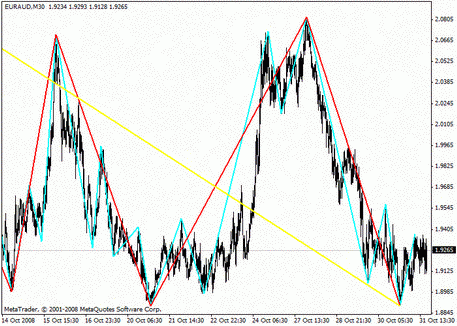
Bolinger
Bollinger Bands is an oscillator indicator that displays the level of the market volatility. It allows determining the price level, relative to the moving average over a recent period. This tool makes it possible to forecast the growth or fall in price, which helps a trader determine the right moment for a successful purchase or sale.
How do the Bollinger Bands work?
The Bollinger Bands work is based on the oversold and overbought markets. Visually, the data is displayed as three lines, where the middle line is a simple moving average, and the upper and lower ones are the levels where the price is considered higher or lower than the moving average.

The top and bottom bands serve to predict the price reversals because the main dynamics occurs within their limits.
- If the price moves to the top line, this means that the asset is overbought now, so it's traded at a high price. It is the right moment to sell because, in the future, the price will rush down to the moving average.
- If the price has reached the bottom line, it means that the asset is oversold, and it's traded at a low price now. In this case, it is logical to make a purchase and then expect the price to move upwards.
It should be noted that the price movement towards the lines can't be a guarantee of a further reversal. If a trader wants to avoid possible losses, then he should check the another technical indicator, and open a deal if the forecast is confirmed only. The trend indicator would be a perfect pair.
Using the Bollinger Bands to measure volatility
Along with determining overbought and oversold assets on the market, the Bollinger Bands indicator is often used by traders to measure the market volatility. In this case, working with the indicator is extremely simple - the longer the distance between the bands is, the higher is the volatility level.

On the chart above, there is a blue area, where the bands keep the shortest distance from each other. Accordingly, the market volatility is very low in this range. In the green zone, the market volatility is increasing, and so this is indicated by the increase in the distance between the lines.
Setting the indicator
In the Bollinger Bands settings, two main parameters allow controlling its operation - the period number and the standard deviation value.
The period means the time interval, on which the indicator makes calculations. By default, the Bollinger Bands are calculated over 20 periods.
- With a decrease in the period number, the reaction speed of the indicator increases, and more waves appear on the graph lines. In this case, the price will often break the upper and lower limits, therefore, giving more signals for trade. However, it's better to know that in this case, the indicator sends false signals frequently, which is associated with a higher risk.
- With an increase in the number of periods, the indicator will react to the price movement more slowly. On the graph, it's displayed by the smoother lines. The price is much less likely to break the levels of the upper and lower bands. Therefore, the indicator sends signals rarely. In this case, the probability of the false signals appearing decreases.
John Bollinger, the author of such a tool, recommended the following period settings, depending on the time frames:
- 10 SMA - on the short time frames;
- 20 SMA - on medium ones;
- 50 SMA - on the long time frames.
In addition to the number of periods, the Bollinger Bands allow a trader to change the standard deviation level. The standard deviation means the distance from the moving average to the upper and lower bands. This parameter determines how much the moving average will affect the indicator.
As the standard deviation increases, the distance between the central moving average and the outside band's increases. Thus, the price moves within limits set by the upper and lower lines and less often breaks the boundaries. By increasing this parameter, the trader gets the opportunity to effectively set the extremum points that the price should reach to break through the bands. It is also worth noting that when the standard deviation increases, the breaks of the bands are less frequent, which means that the indicator signals become more reliable.
Trading Features
Forex trading using the Bollinger Bands is a bit similar to working with the moving averages.
- Open the transaction when the price broke through the middle line, following the direction of its movement. Exit from the market is carried out when the price has reached the other band;
- You can enter the market at a time when the price has come to the outside line, in the opposite direction. It can be considered quite risky since the price can keep moving without turning. This tactic should be used by experienced traders only, checking with the other indicators.
- Bollinger Bands can also be used by a trader to establish the support or resistance levels. Such a way of the indicator use is fundamental, especially for the extended periods.
Summary
The Bollinger Bands is a standard Forex indicator, which's hard to overrate. However, just like all the oscillator indicators, it needs to be tuned properly so that a trader could avoid the false signals. Also, it's worth to remember that making transactions based on the single indicator, involves a high risk. Therefore, we recommend to use this tool along with another indicator, which will help the trader to assess the market situation better, and to make the right decision.

 English
English
 русский
русский








